BUSN3033 - Occupational Health and Safety: Workplace Hazard Report
VerifiedAdded on 2023/06/04
|5
|1286
|315
Report
AI Summary
This report presents findings from a workplace health and safety assessment, identifying potential hazards and analyzing risks within a healthcare organization. Data was collected through interviews with staff, observations during a site tour using checklists, and a review of organizational documents, including OHS policies and reports. The study highlights various types of injuries and hazards, such as entanglements, crushes, slippery surfaces, and exposure to hazardous chemicals. It also examines the violation of workplace safety norms and the rise in accidents due to unsafe conditions. The report references accident causation theories like the Henrich Domino Theory and Ferrell’s Human Factor Model. Further observations include instances of cuts, punctures, and exposure to high temperatures and pressures. The report concludes by noting unsafe equipment practices, inappropriate handling of electricity and liquids, and unhygienic working conditions, emphasizing the need for improved safety measures and adherence to OHS policies. Desklib provides access to similar reports and study resources.
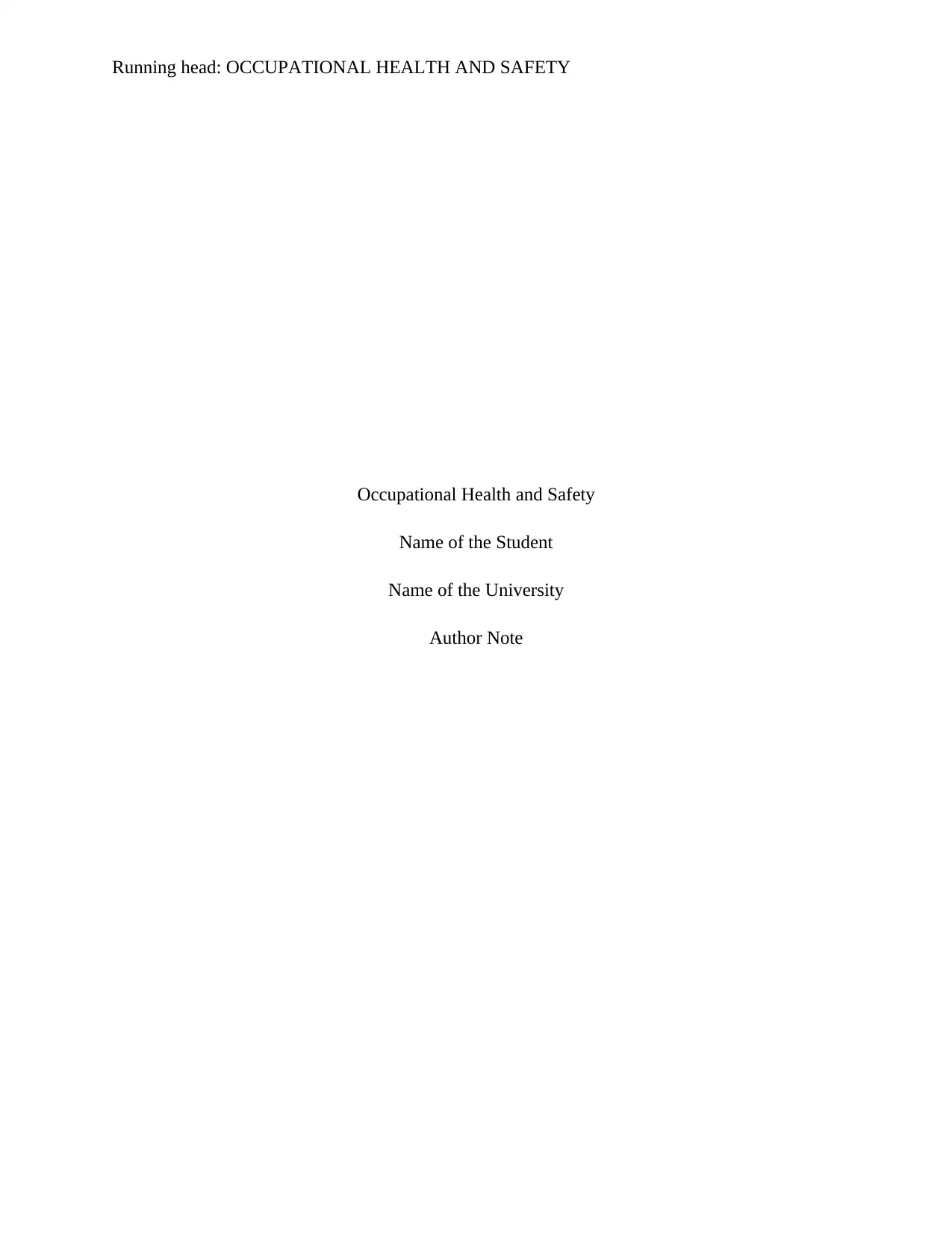
Running head: OCCUPATIONAL HEALTH AND SAFETY
Occupational Health and Safety
Name of the Student
Name of the University
Author Note
Occupational Health and Safety
Name of the Student
Name of the University
Author Note
Paraphrase This Document
Need a fresh take? Get an instant paraphrase of this document with our AI Paraphraser
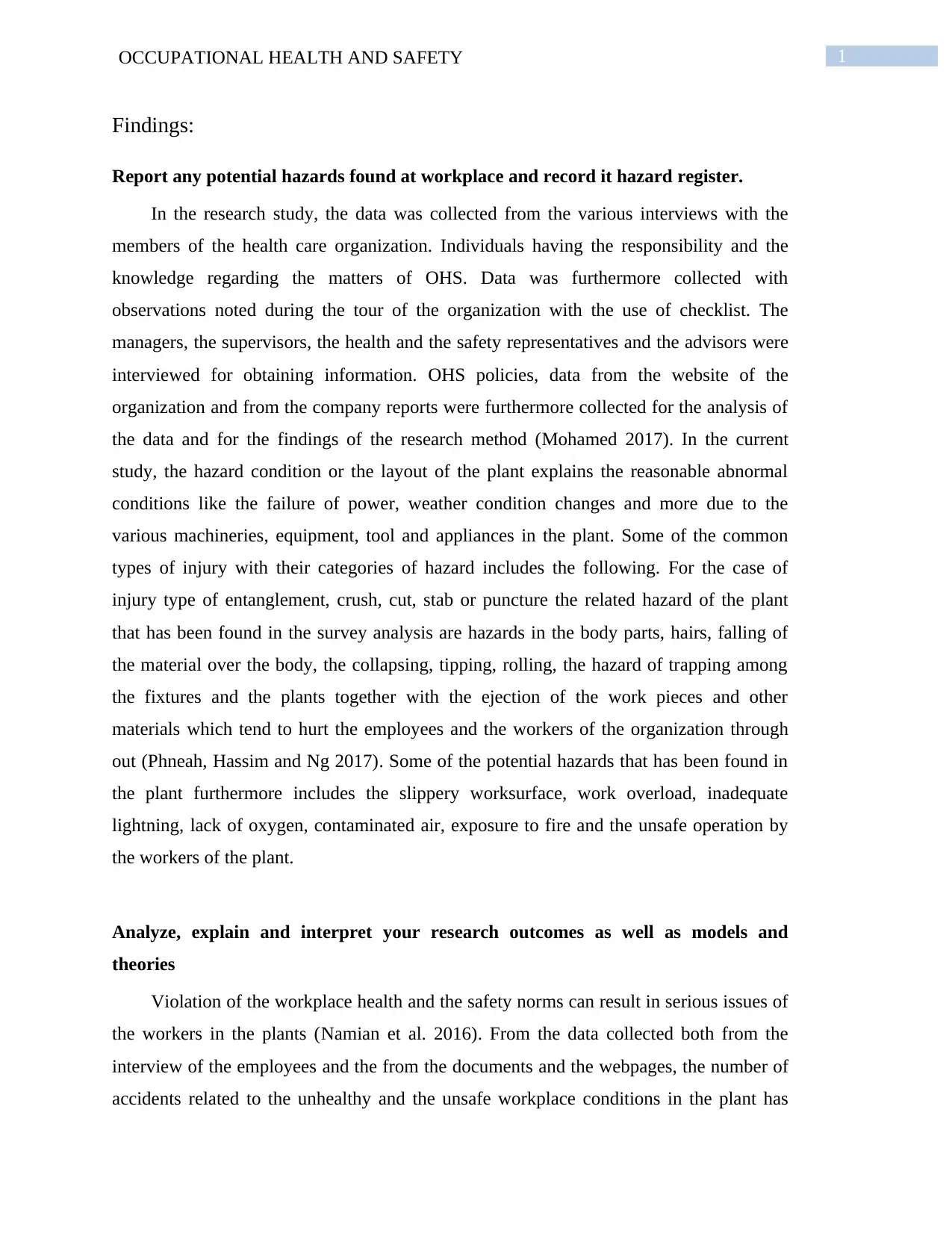
1OCCUPATIONAL HEALTH AND SAFETY
Findings:
Report any potential hazards found at workplace and record it hazard register.
In the research study, the data was collected from the various interviews with the
members of the health care organization. Individuals having the responsibility and the
knowledge regarding the matters of OHS. Data was furthermore collected with
observations noted during the tour of the organization with the use of checklist. The
managers, the supervisors, the health and the safety representatives and the advisors were
interviewed for obtaining information. OHS policies, data from the website of the
organization and from the company reports were furthermore collected for the analysis of
the data and for the findings of the research method (Mohamed 2017). In the current
study, the hazard condition or the layout of the plant explains the reasonable abnormal
conditions like the failure of power, weather condition changes and more due to the
various machineries, equipment, tool and appliances in the plant. Some of the common
types of injury with their categories of hazard includes the following. For the case of
injury type of entanglement, crush, cut, stab or puncture the related hazard of the plant
that has been found in the survey analysis are hazards in the body parts, hairs, falling of
the material over the body, the collapsing, tipping, rolling, the hazard of trapping among
the fixtures and the plants together with the ejection of the work pieces and other
materials which tend to hurt the employees and the workers of the organization through
out (Phneah, Hassim and Ng 2017). Some of the potential hazards that has been found in
the plant furthermore includes the slippery worksurface, work overload, inadequate
lightning, lack of oxygen, contaminated air, exposure to fire and the unsafe operation by
the workers of the plant.
Analyze, explain and interpret your research outcomes as well as models and
theories
Violation of the workplace health and the safety norms can result in serious issues of
the workers in the plants (Namian et al. 2016). From the data collected both from the
interview of the employees and the from the documents and the webpages, the number of
accidents related to the unhealthy and the unsafe workplace conditions in the plant has
Findings:
Report any potential hazards found at workplace and record it hazard register.
In the research study, the data was collected from the various interviews with the
members of the health care organization. Individuals having the responsibility and the
knowledge regarding the matters of OHS. Data was furthermore collected with
observations noted during the tour of the organization with the use of checklist. The
managers, the supervisors, the health and the safety representatives and the advisors were
interviewed for obtaining information. OHS policies, data from the website of the
organization and from the company reports were furthermore collected for the analysis of
the data and for the findings of the research method (Mohamed 2017). In the current
study, the hazard condition or the layout of the plant explains the reasonable abnormal
conditions like the failure of power, weather condition changes and more due to the
various machineries, equipment, tool and appliances in the plant. Some of the common
types of injury with their categories of hazard includes the following. For the case of
injury type of entanglement, crush, cut, stab or puncture the related hazard of the plant
that has been found in the survey analysis are hazards in the body parts, hairs, falling of
the material over the body, the collapsing, tipping, rolling, the hazard of trapping among
the fixtures and the plants together with the ejection of the work pieces and other
materials which tend to hurt the employees and the workers of the organization through
out (Phneah, Hassim and Ng 2017). Some of the potential hazards that has been found in
the plant furthermore includes the slippery worksurface, work overload, inadequate
lightning, lack of oxygen, contaminated air, exposure to fire and the unsafe operation by
the workers of the plant.
Analyze, explain and interpret your research outcomes as well as models and
theories
Violation of the workplace health and the safety norms can result in serious issues of
the workers in the plants (Namian et al. 2016). From the data collected both from the
interview of the employees and the from the documents and the webpages, the number of
accidents related to the unhealthy and the unsafe workplace conditions in the plant has
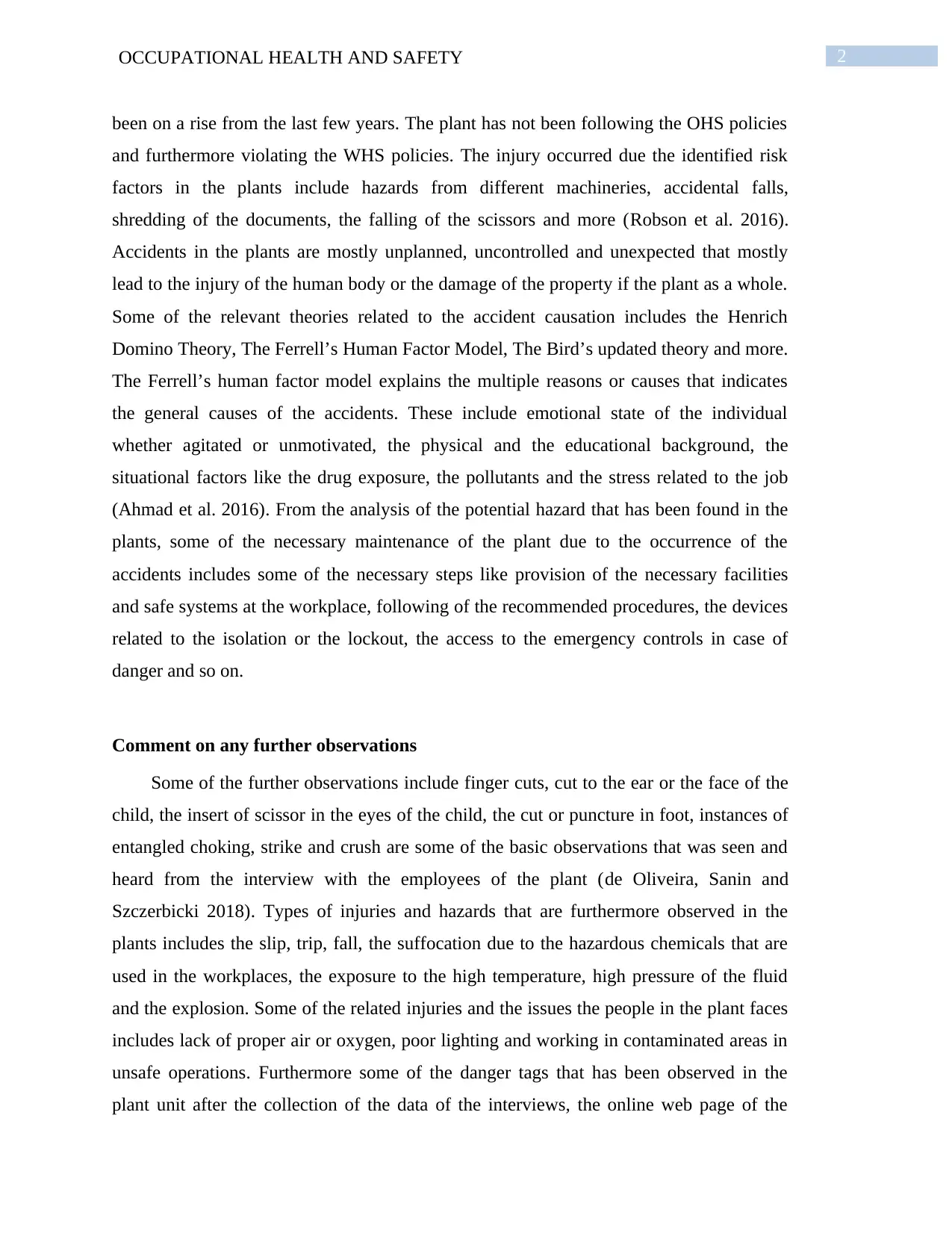
2OCCUPATIONAL HEALTH AND SAFETY
been on a rise from the last few years. The plant has not been following the OHS policies
and furthermore violating the WHS policies. The injury occurred due the identified risk
factors in the plants include hazards from different machineries, accidental falls,
shredding of the documents, the falling of the scissors and more (Robson et al. 2016).
Accidents in the plants are mostly unplanned, uncontrolled and unexpected that mostly
lead to the injury of the human body or the damage of the property if the plant as a whole.
Some of the relevant theories related to the accident causation includes the Henrich
Domino Theory, The Ferrell’s Human Factor Model, The Bird’s updated theory and more.
The Ferrell’s human factor model explains the multiple reasons or causes that indicates
the general causes of the accidents. These include emotional state of the individual
whether agitated or unmotivated, the physical and the educational background, the
situational factors like the drug exposure, the pollutants and the stress related to the job
(Ahmad et al. 2016). From the analysis of the potential hazard that has been found in the
plants, some of the necessary maintenance of the plant due to the occurrence of the
accidents includes some of the necessary steps like provision of the necessary facilities
and safe systems at the workplace, following of the recommended procedures, the devices
related to the isolation or the lockout, the access to the emergency controls in case of
danger and so on.
Comment on any further observations
Some of the further observations include finger cuts, cut to the ear or the face of the
child, the insert of scissor in the eyes of the child, the cut or puncture in foot, instances of
entangled choking, strike and crush are some of the basic observations that was seen and
heard from the interview with the employees of the plant (de Oliveira, Sanin and
Szczerbicki 2018). Types of injuries and hazards that are furthermore observed in the
plants includes the slip, trip, fall, the suffocation due to the hazardous chemicals that are
used in the workplaces, the exposure to the high temperature, high pressure of the fluid
and the explosion. Some of the related injuries and the issues the people in the plant faces
includes lack of proper air or oxygen, poor lighting and working in contaminated areas in
unsafe operations. Furthermore some of the danger tags that has been observed in the
plant unit after the collection of the data of the interviews, the online web page of the
been on a rise from the last few years. The plant has not been following the OHS policies
and furthermore violating the WHS policies. The injury occurred due the identified risk
factors in the plants include hazards from different machineries, accidental falls,
shredding of the documents, the falling of the scissors and more (Robson et al. 2016).
Accidents in the plants are mostly unplanned, uncontrolled and unexpected that mostly
lead to the injury of the human body or the damage of the property if the plant as a whole.
Some of the relevant theories related to the accident causation includes the Henrich
Domino Theory, The Ferrell’s Human Factor Model, The Bird’s updated theory and more.
The Ferrell’s human factor model explains the multiple reasons or causes that indicates
the general causes of the accidents. These include emotional state of the individual
whether agitated or unmotivated, the physical and the educational background, the
situational factors like the drug exposure, the pollutants and the stress related to the job
(Ahmad et al. 2016). From the analysis of the potential hazard that has been found in the
plants, some of the necessary maintenance of the plant due to the occurrence of the
accidents includes some of the necessary steps like provision of the necessary facilities
and safe systems at the workplace, following of the recommended procedures, the devices
related to the isolation or the lockout, the access to the emergency controls in case of
danger and so on.
Comment on any further observations
Some of the further observations include finger cuts, cut to the ear or the face of the
child, the insert of scissor in the eyes of the child, the cut or puncture in foot, instances of
entangled choking, strike and crush are some of the basic observations that was seen and
heard from the interview with the employees of the plant (de Oliveira, Sanin and
Szczerbicki 2018). Types of injuries and hazards that are furthermore observed in the
plants includes the slip, trip, fall, the suffocation due to the hazardous chemicals that are
used in the workplaces, the exposure to the high temperature, high pressure of the fluid
and the explosion. Some of the related injuries and the issues the people in the plant faces
includes lack of proper air or oxygen, poor lighting and working in contaminated areas in
unsafe operations. Furthermore some of the danger tags that has been observed in the
plant unit after the collection of the data of the interviews, the online web page of the
⊘ This is a preview!⊘
Do you want full access?
Subscribe today to unlock all pages.

Trusted by 1+ million students worldwide
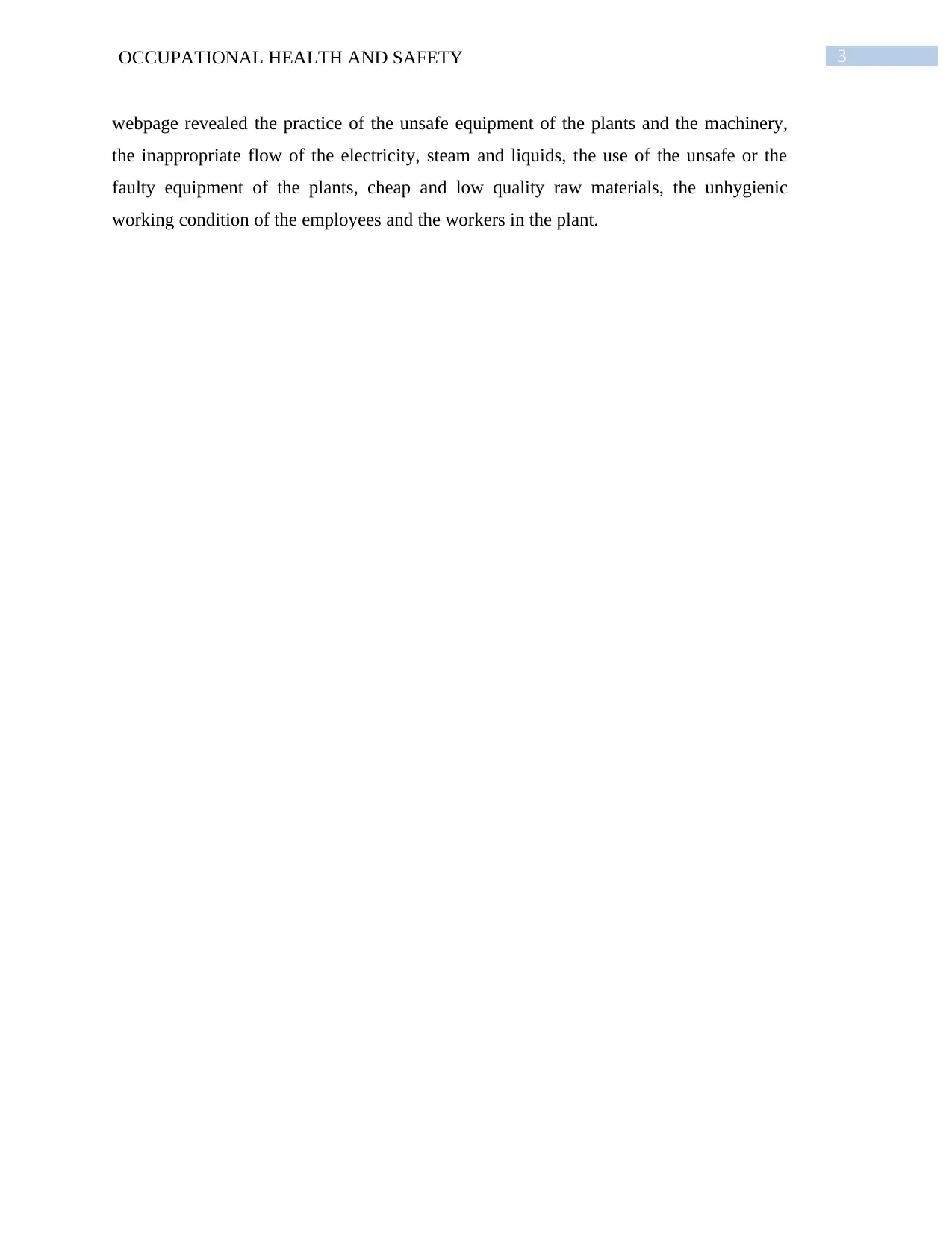
3OCCUPATIONAL HEALTH AND SAFETY
webpage revealed the practice of the unsafe equipment of the plants and the machinery,
the inappropriate flow of the electricity, steam and liquids, the use of the unsafe or the
faulty equipment of the plants, cheap and low quality raw materials, the unhygienic
working condition of the employees and the workers in the plant.
webpage revealed the practice of the unsafe equipment of the plants and the machinery,
the inappropriate flow of the electricity, steam and liquids, the use of the unsafe or the
faulty equipment of the plants, cheap and low quality raw materials, the unhygienic
working condition of the employees and the workers in the plant.
Paraphrase This Document
Need a fresh take? Get an instant paraphrase of this document with our AI Paraphraser
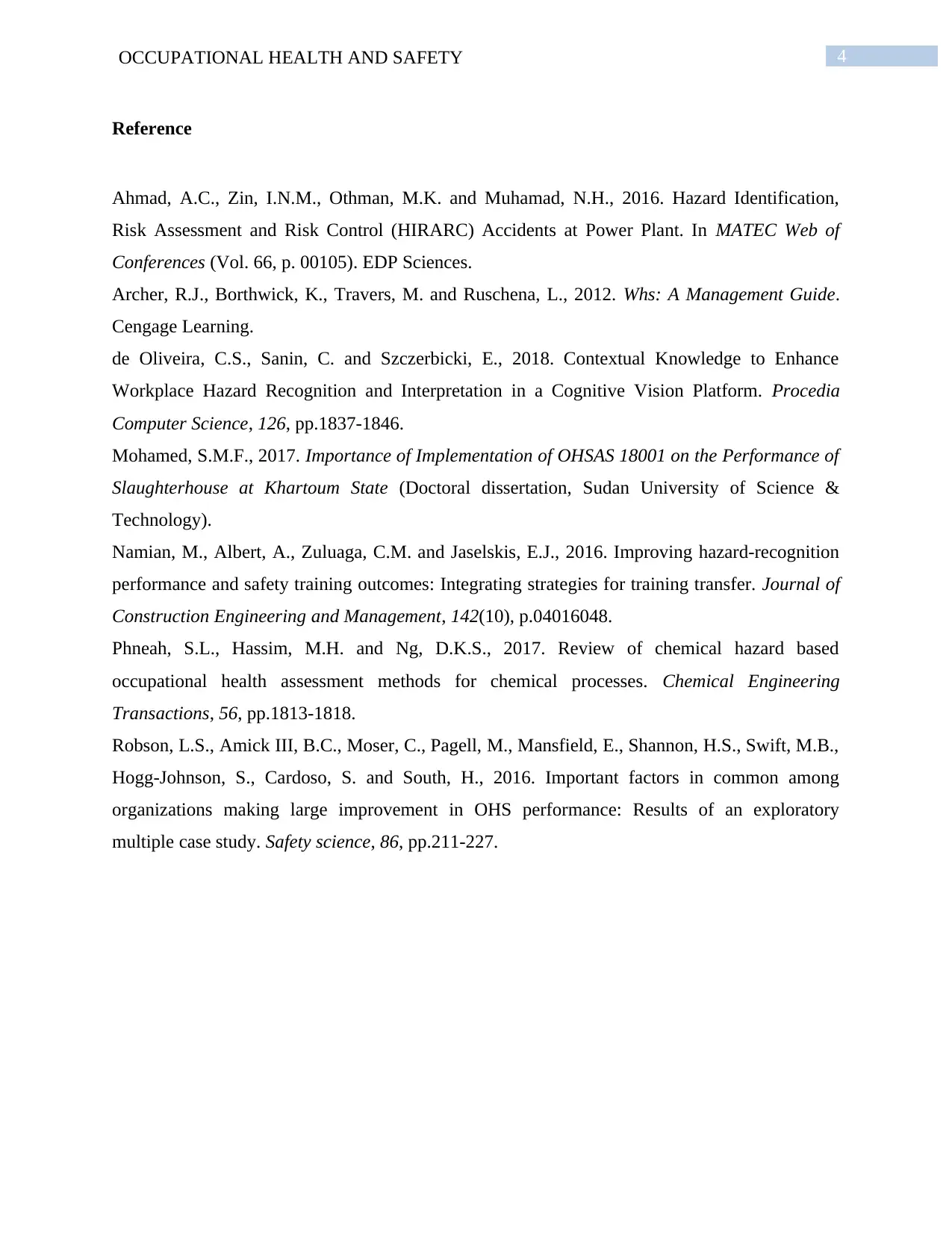
4OCCUPATIONAL HEALTH AND SAFETY
Reference
Ahmad, A.C., Zin, I.N.M., Othman, M.K. and Muhamad, N.H., 2016. Hazard Identification,
Risk Assessment and Risk Control (HIRARC) Accidents at Power Plant. In MATEC Web of
Conferences (Vol. 66, p. 00105). EDP Sciences.
Archer, R.J., Borthwick, K., Travers, M. and Ruschena, L., 2012. Whs: A Management Guide.
Cengage Learning.
de Oliveira, C.S., Sanin, C. and Szczerbicki, E., 2018. Contextual Knowledge to Enhance
Workplace Hazard Recognition and Interpretation in a Cognitive Vision Platform. Procedia
Computer Science, 126, pp.1837-1846.
Mohamed, S.M.F., 2017. Importance of Implementation of OHSAS 18001 on the Performance of
Slaughterhouse at Khartoum State (Doctoral dissertation, Sudan University of Science &
Technology).
Namian, M., Albert, A., Zuluaga, C.M. and Jaselskis, E.J., 2016. Improving hazard-recognition
performance and safety training outcomes: Integrating strategies for training transfer. Journal of
Construction Engineering and Management, 142(10), p.04016048.
Phneah, S.L., Hassim, M.H. and Ng, D.K.S., 2017. Review of chemical hazard based
occupational health assessment methods for chemical processes. Chemical Engineering
Transactions, 56, pp.1813-1818.
Robson, L.S., Amick III, B.C., Moser, C., Pagell, M., Mansfield, E., Shannon, H.S., Swift, M.B.,
Hogg-Johnson, S., Cardoso, S. and South, H., 2016. Important factors in common among
organizations making large improvement in OHS performance: Results of an exploratory
multiple case study. Safety science, 86, pp.211-227.
Reference
Ahmad, A.C., Zin, I.N.M., Othman, M.K. and Muhamad, N.H., 2016. Hazard Identification,
Risk Assessment and Risk Control (HIRARC) Accidents at Power Plant. In MATEC Web of
Conferences (Vol. 66, p. 00105). EDP Sciences.
Archer, R.J., Borthwick, K., Travers, M. and Ruschena, L., 2012. Whs: A Management Guide.
Cengage Learning.
de Oliveira, C.S., Sanin, C. and Szczerbicki, E., 2018. Contextual Knowledge to Enhance
Workplace Hazard Recognition and Interpretation in a Cognitive Vision Platform. Procedia
Computer Science, 126, pp.1837-1846.
Mohamed, S.M.F., 2017. Importance of Implementation of OHSAS 18001 on the Performance of
Slaughterhouse at Khartoum State (Doctoral dissertation, Sudan University of Science &
Technology).
Namian, M., Albert, A., Zuluaga, C.M. and Jaselskis, E.J., 2016. Improving hazard-recognition
performance and safety training outcomes: Integrating strategies for training transfer. Journal of
Construction Engineering and Management, 142(10), p.04016048.
Phneah, S.L., Hassim, M.H. and Ng, D.K.S., 2017. Review of chemical hazard based
occupational health assessment methods for chemical processes. Chemical Engineering
Transactions, 56, pp.1813-1818.
Robson, L.S., Amick III, B.C., Moser, C., Pagell, M., Mansfield, E., Shannon, H.S., Swift, M.B.,
Hogg-Johnson, S., Cardoso, S. and South, H., 2016. Important factors in common among
organizations making large improvement in OHS performance: Results of an exploratory
multiple case study. Safety science, 86, pp.211-227.
1 out of 5
Related Documents
Your All-in-One AI-Powered Toolkit for Academic Success.
+13062052269
info@desklib.com
Available 24*7 on WhatsApp / Email
![[object Object]](/_next/static/media/star-bottom.7253800d.svg)
Unlock your academic potential
Copyright © 2020–2025 A2Z Services. All Rights Reserved. Developed and managed by ZUCOL.





